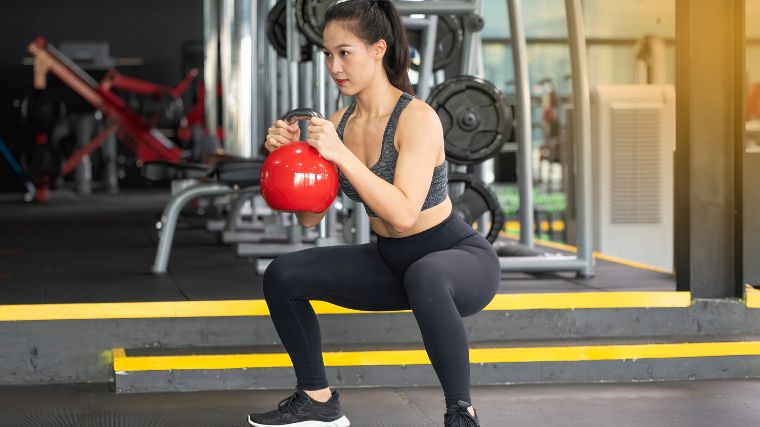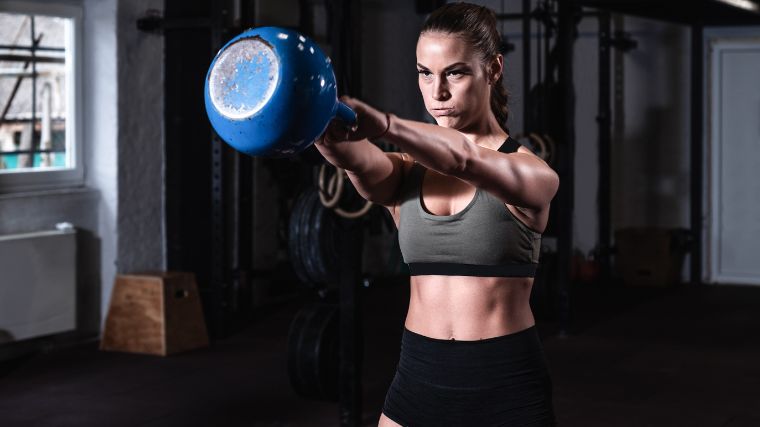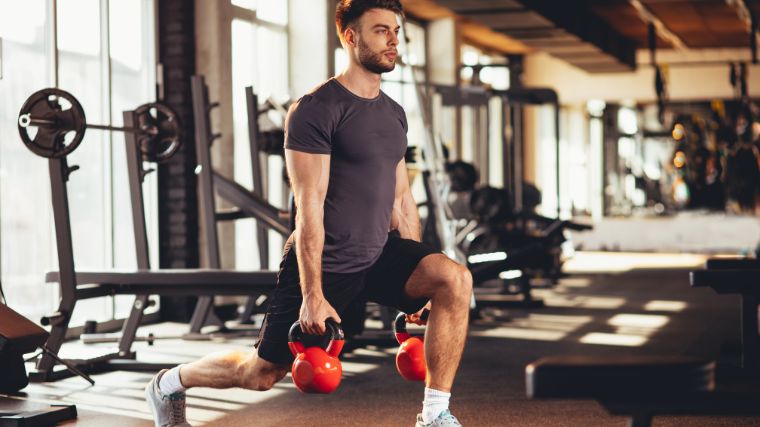For your next workout, if you’re looking for a way to target every major muscle group in a time crunch, look no further than the versatility of the kettlebell. With the kettlebell, your next full-body workout can effectively explore the essential fundamental movement patterns: the squat, lunge, hinge, rotation, push, pull, and carry.
Kettlebells can carry the day for beginners, begin-againers, seasoned strength athletes, and everyone in between. These uniquely-shaped tools can help you increase strength and conditioning, build muscle, and boost cardiovascular endurance. No matter where you’re coming from, kettlebells can help move you along your fitness journey.

Get kettlebell curious and ready to have fun navigating the basics. Then, start spicing things up with even more ways to challenge yourself. Wherever you’re starting from, dive in with the best full-body kettlebell workout for every experience level and every body.
The Best Full-Body Kettlebell Workouts
The Best Full-Body Kettlebell Workout for Beginners
You’re looking at other athletes’ kettlebell workouts in the gym, and frankly, they can be inspiring. When you see a powerful kettlebell swing or exceptional Turkish get-up, the instinct may be to get straight to that kind of exercise.
But to prepare your body to advance into those movements and manage injury risk, you’ve got to start with the basics.
Kettlebell beginners may be surprised at how heavy a kettlebell feels. To get started, your focus will be on building core strength and stability with anti-rotation, increasing your time under tension, and getting familiar with the anatomy of the kettlebell with the introduction of simple ballistics.
The Workout
Are you tired of being a beginner? It makes sense — there’s undeniable attention on the glitz and glam of expert kettlebell training. But no one skips the start. Here, you’ll build the foundation to reach your full potential.
With this workout, you’ll be working on a lot of repetitions with a solid number of exercises. Pushing through them will build your strength and endurance as well as your athletic tenacity and mental grit.

[Read More: The Best Foods for Energy Before, During, and After Your Workouts]
Follow each exercise one by one. Rest from 45 to 60 secs between sets and one to two minutes between exercises. Try staying in this phase for three to four weeks. After week two, add a set each week until you get to four sets in week four.
This workout will be performed with one kettlebell using two hands.
- Hardstyle Plank: 2 x 30 seconds
- Suitcase March Left: 2 x 30 seconds
- Suitcase March Right: 2 x 30 seconds
- Deadlift: 2 x 12
- Dead-Stop Goblet Clean: 2 x 12
- Goblet Squat: 2 x 10
- Goblet Press: 2 x 8-10
Coach’s Tip: You can use chair or bench support to incorporate variations like a plank on a bench instead of the floor. Seated marching or performing a deadlift or squat with a chair can also make these movements more accessible to you.
Try them and remember you can use these customization tools at any time, for any reason — no matter your experience level.
The Best Full-Body Kettlebell Workout for Intermediates
Creating a kettlebell complex is the next step to building up your kettlebell skills and pushing yourself to the next level. You started your beginner workout focusing on individual exercises, finessing your technique, and getting intentional to learn the movement. Kettlebell complexes allow you to push your intensity by stringing compound movements together without a break or pause.

[Read More: The Complete Guide to Pre-Workout Supplements]
A kettlebell flow typically looks like a sequence of different movements performed one rep at a time in a chain. Alternatively, a complex includes multiple reps of a movement strung together in a chain. Both styles will increase the difficulty level for more muscle building and increased cardiovascular endurance.
The Workout
Perform the exercises as a complex, completing one set of reps for each exercise before moving to the next move without a pause. Completing all reps, on both sides (if appropriate) concludes one set of the complex.
This workout will be performed unilaterally, with one kettlebell moved by a single arm. When you’ve gone through the complex three times on one side, repeat on the other. You can also alternate between arms, completing a complex with your right side, then with your left, etc.
- Dead-Stop Swing Right: 3 x 5
- Front Squat Left: 3 x 5
- Push Press Left: 3 x 5
- Rack Lunge Left: 3 x 6
- Heavy Goblet March: 3 x 30 secs
Coach’s Tip: Increase knee stability by utilizing a wedge or slant board with your squats. This will help you bring your pelvis back to keep your knees wide and hips and ankles open for a greater range of motion.
The Best Full-Body Kettlebell Workout for Advanced Athletes
Now that you have progressed to the advanced, be sure not to neglect your warm-up and cool-down stretches. Here, you’ll challenge your cardiovascular fitness, strength, mobility, and flexibility all at once.
[Read More: Nutrition for Athletes — How to Eat for Muscle and Performance]
Just because you’re at an advanced level doesn’t mean that you need to forego the use of customization tools. You can still modify movements as needed to suit your body’s needs.
The Workout
These exercises will hit your lower body, upper body, and core, test your grip strength, and get your heart racing. String each exercise into a complex, then complete that complex for three to five rounds. Rest for two minutes between complexes.
This workout will be performed with two kettlebells.
- Double Bottoms-Up March: 3-5 x 20 alternating sides
- Clean and Reverse Lunge: 3-5 x 12 alternating sides
- Double Thruster: 3-5 x 10
- Renegade Row: 3-5 x 12 alternating sides
- Double Swing: 3-5 x 10
- Farmer’s Carry: 3-5 x 50 meters
Coach’s Tip: Perform lunges alternating left and right with a clean between each pair of lunges.
Kettlebell Props for Every Experience Level
Wait, this isn’t a yoga class — so why might you need props like yoga blocks?
Everybody has a different shape and size; limbs make different lever lengths; and kettlebell manufacturing varies. Props can increase accessibility and support for all body types so that you never have to feel like a movement isn’t for you because of your size or shape.
Yoga blocks can “raise the floor” beneath a kettlebell so that you don’t have to hinge down as far to perform a deadlift. Inversely, you can also stand on a bumper plate or weight plate to elevate your body, creating more range of motion as you move from beginner to advanced full-body kettlebell workouts.
Recommended Accessories & Props For More Accessible Workouts
Not sure which accessories to start with? Peruse this list to see which pieces of equipment can best help you on your kettlebell journey.
- Yoga Block, Weight Plates/Bumper Plates, or Heavy Books: Place the kettlebell on one of these to “raise the floor” to decrease your range of motion; or stand on one to increase your range of motion.
- Wedges or Slant Board: Assist yourself with squats by helping decrease the need for ankle mobility, which you can build over time.
- Cushion: Make the floor more comfortable if you’re performing exercises in a kneeling position; raise your hips to make certain seated positions more accessible.
- Yoga Mat: Give yourself a stable, padded surface to work on.
- Performance Chalk: Make the kettlebell easier to grip, whether you have sweaty palms or just need a little extra support for your grip strength.
- Armless Chair or Weight Bench: Use these when you need to perform exercises from a seated position; you can also use them for box squats to help learn and adjust to deep squatting with safe form.
- Wrist Guards or Wrist Sweatbands: Support and protect your wrists from unintentionally flexing or hyperextending; support folks with smaller bones; help athletes who are new to pressure on the forearm to reduce pain or discomfort in initial kettlebell conditioning; help protect your hands from sweat that could make gripping the bell more difficult.
Benefits of Full-Body Kettlebell Workouts
Working your whole body with kettlebells is training at peak efficiency. That’s because you’re building more muscle, increasing strength, and providing low-impact conditioning to your body all at once. But the benefits don’t stop there. These workouts are accessible to more bodies and align with a variety of goals.
Accessible Training With a Fixed Weight
Your current approach to progressive overload may involve slapping on more and more weight plates as you get stronger. While that’s certainly a part of increasing workout intensity, you can get stronger without going up in weight.
With kettlebell workouts, working in flows and complexes can get you a full-body workout with only a single moderate-to-heavy kettlebell. By increasing your set or rep count each week and gradually decreasing rest periods, you can go without increasing the size of the kettlebell for a very long time. This means a cheaper, more accessible at-home workout.
Flexible Programming to Fit Your Goals
Whether you’re a martial artist, a powerlifter, an adaptive athlete who uses a wheelchair, or all of the above, kettlebell training can serve you well. You can use a balanced full-body kettlebell workout as an accessory to your main training protocol without over-taxing any one muscle group.
[Read More: The 15 Best Home Gyms (Spring 2023 Update)]
Because these workouts are so low impact in nature, they’re relatively easy to add as a supplement to your current sports training regimen. Or, if you’re a beginner, they’re intense enough to serve as your main workout program.
Brain-Healthy Training
Typically, one might think of strength training programs as being all about skeletal muscles. But the mind is also important to train.
With kettlebells, you can enrich your mind-muscle connection by challenging yourself to learn unique movements and coordination challenges. You’ll train the brain to think faster, focus better, improve your memory, and boost your mood. These workouts may also help reduce your risk of Alzheimer’s and forms of dementia. (1)
Who Should Perform Full-Body Kettlebell Workouts
There’s no cap here! Everyone and every body can embrace a full-body kettlebell workout from time to time. Athletes of all kinds will learn a lot — and challenge their bodies — by exploring the technique and noticing how the kettlebell responds to their movement.
Beginners
Making your way through a long list of exercises targeting every muscle group can be tedious and disheartening for a beginner. That’s especially true if you’re starting on your own without a coach or trainer.

A full-body kettlebell workout can be done in 15 to 20 minutes and gives you everything you need, step-by-step, to accomplish nearly any fitness goal. They’re user-friendly and you don’t even need to perform them in a gym.
Powerlifters
Primarily, powerlifters work with barbells. But kettlebell training can help increase your endurance and work capacity in ways that may be difficult to replicate with training for the big three lifts alone.
Working with kettlebells can help powerlifters improve their explosive strength for bigger and more powerful lifts. It will also provide a low-impact conditioning challenge that can help powerlifters lay the groundwork for a higher work capacity and training tolerance.
Strongwoman and Strongman Athletes
Strongman athletes of any gender can do more with kettlebells than toss them. Since this tool provides a low-impact way to pack a cardiovascular punch, strongman athletes can integrate these moves to improve unilateral strength, mobility, and conditioning — all essential on the competition floor.
Martial Artists
Combat athletes, strikers, and grapplers get to actively train stabilizer muscles and build rotational strength with kettlebells. This can help with increased striking speed and reduced likelihood of common knee and shoulder injuries.
How to Progress Full-Body Kettlebell Workouts
There are so many ways to progress your full-body kettlebell workouts. You can manipulate your range of motion, vary your tempo, and change your training density to amplify your goals of getting faster, stronger, and bringing explosive power.
Range of Motion
Learning to control your body and increase your strength at different ranges of motion is key in kettlebell exercises. Journeying through kettlebell training is all about increasing your range of motion for better mobility, movement quality, and hypertrophy potential.
For example, if you’re just learning to deadlift, do so from a yoga block so that your range of motion is shortened. When you’ve learned that skill, take away the block. Start deadlifting from the floor, increasing the range of motion with your hip hinge.
Once you’re an expert there, up your range of motion even further by raising the floor to perform a deficit kettlebell deadlift. This will load your glutes more than a conventional kettlebell deadlift. You can follow similar procedures for various kettlebell moves to progressively overload your muscles.
Variations of Tempo
Let’s be honest — the unique shape and offset center of mass of the kettlebell makes for a tough workout. It challenges deep layers of your core and stabilizers, everywhere from your toes to your fingers.
Once you’ve locked in your technique with various movements, your ability to manipulate your time under tension (TUT) in tempo training with kettlebells will amplify your gains. You can perform variations of quick explosive lifts to speed up your tempo and generate more power.
Alternatively, you can slow down your pace in the eccentric (lowering) component of different lifts to increase strength and muscle-building potential.
AMRAP
Instead of reps, you can train for time. Increased training density means increasing your intensity by packing in as much work as possible in a limited amount of time.
One way to boost your training density is to perform AMRAPs — as many reps or rounds as possible in a given time frame. For example, aim to complete as many rounds as possible of a kettlebell complex, with good form, within 20 mins. Note your result and aim to beat it the next time you complete the workout.

Don’t sacrifice your form or technique for a few extra reps — so be honest with yourself about the rep quality over quantity.
Bring on the Flavor
Take your time to explore the versatility of your favorite full-body kettlebell workout. Before long, you’ll be fully into the swing of things. Be ready to watch your athleticism skyrocket to the next level. Whether you’re a beginner, intermediate, or advanced athlete, kettlebells are that pinch of salt that brings the flavor to every workout.
Once the momentum of the kettlebell takes your power to the next level, you’ll never want to leave the house without a kettlebell buckled into your backseat.
References
- De la Rosa A, Olaso-Gonzalez G, Arc-Chagnaud C, Millan F, Salvador-Pascual A, García-Lucerga C, Blasco-Lafarga C, Garcia-Dominguez E, Carretero A, Correas AG, Viña J, Gomez-Cabrera MC. Physical exercise in the prevention and treatment of Alzheimer’s disease. J Sport Health Sci. 2020 Sep;9(5):394-404.
Featured Image: Damali Fraiser / Photograph by Cynthia Keeshan